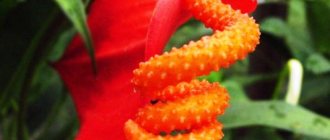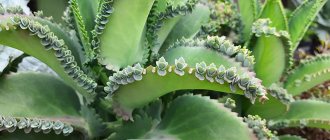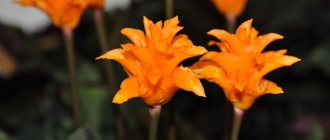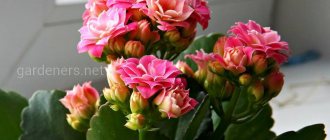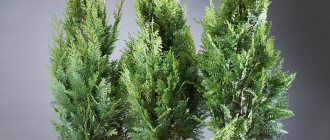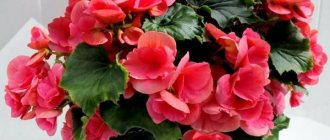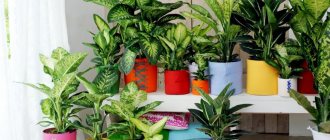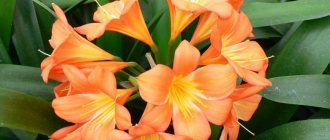Features of planting anthurium
In order for anthurium, or, as it is also called, “male happiness,” to please with its delightful flowering with bright red, orange or pink “cloaks,” be sure to plant it in a suitable soil mixture.
There are several options! This can be a special soil for aroid plants, which is lightweight and has excellent breathability due to the addition of coarse sand and crushed charcoal. Anthurium also grows well in soil for orchids, consisting of small pieces of tree bark; in this case, even drainage is not needed.
Photo: agrodom93.ru
How to choose land?
Before planting, the soil must be disinfected by treating it with a fungicide or thermally (oven, water bath).
Soil composition
You can use a purchased substrate for orchids, Saintpaulia, as it meets the acidity requirements (pH 4.5 - 6.5), but this is not an ideal option. It is better to prepare the substrate yourself:
mix turf soil;- humus;
- perlite or vermiculite in a ratio of 1:3:1.
As an option:
- soil for azaleas or rhododendrons;
- peat;
- pieces of bark;
- expanded clay (up to 3 mm);
- crushed moss - sphagnum in equal proportions.
Another recipe: mix 2 parts of leaf soil with 4 parts of humus, 1 part of sand and 2 parts of peat. Such soil will be air- and water-permeable, loose and light.
Requirements for transplantation
Until “male happiness” reaches the age of five, replant it annually in a pot that is slightly larger in volume than the previous one. Then you can replant the plant once every 3 years, but be sure to remove damaged roots and plant new shoots. Don’t forget to add a layer of new coarse-grained drainage, pre-disinfected with boiling water, to the bottom of the pot (if you are using a soil mixture) to protect the root system from rotting.
Little trick:
If you want your anthurium to bloom profusely, then grow it in a pot that is a little too small for its roots. If you want to get “babies”, then transplant the plant into a spacious pot, very soon you will see that young shoots have begun to appear.
Photo: commons.wikimedia.org
Choosing a pot
Material
Anthurium prefers plastic or glass, since these substances are not hygroscopic and, therefore, do not allow air and heat to pass through to the roots (there is no heat during the day, and the soil remains dry at night), unlike natural materials.
Plastic and glass do not allow roots to “grow” into the walls of the pot, which will inevitably lead to their breaking and injury during transplantation.
Size
An anthurium pot should not be spacious , since its roots will develop freely without intertwining in a cramped container, and the plant will be busy developing new lands rather than flowering. The pot must be wide: aerial shoots require access to the soil for rooting.
In appearance, the container for anthurium should resemble a bowl - shallow and wide. A prerequisite: the presence of drainage holes and drainage material (expanded clay), which will fill the pot to a quarter of its volume. For a young plant, you can take a pot whose diameter is 8–10 cm.
Anthurium belongs to the Araceae family, and like all representatives of this family, anthurium is poisonous. The juice of the plant, if it gets on the skin and mucous membranes, can cause allergic reactions (redness, itching, rash). Therefore, you must remember: before you start propagating this plant, you must wear gloves, and when finished, wash your hands thoroughly with water.
How to prepare for planting?
A lateral shoot that is strong and without visible damage should be separated from the mother plant.- If it was not possible to successfully separate the shoot from the mother plant, and the roots have broken off or are very weak, then before planting the shoot in a separate container, you can try rooting it in damp moss, sand or perlite.
A necessary condition for any type of rooting is the subsequent obligatory placement of the plant in a mini-greenhouse: for the development of the root system, high temperatures and air humidity are required.Such conditions can be achieved by placing the container with the shoot in a plastic bag, a plastic food container with a tight-fitting lid, or in a cut plastic bottle.
- With the appearance of strong roots, the greenhouse can be removed. But it is also important to remember that such a greenhouse should be opened slightly for ventilation every day, otherwise the shoot may simply rot.
Watering and spraying anthurium
All types of anthurium love water. In this regard, it is necessary to water it quite abundantly. As soon as you see that the top layer of soil has begun to dry out, water the plant thoroughly. Under no circumstances leave water in the saucer, otherwise the roots will begin to rot; drain the tray immediately after watering.
The soil mixture in the pot must not be allowed to dry out, otherwise the flower will stop growing, producing new leaves and flowers, and possibly wilting and developing diseases. But excessive watering is also deadly for anthurium, as is a long period of drought.
“Male Happiness” does not tolerate dry air well. Place a pot with a plant next to the aquarium or get a humidifier. You can also spray the air around the anthurium with a spray bottle. Try to prevent large droplets of water from falling on the leaves and flowers; after the moisture evaporates, whitish spots will remain on the surface of the bush, which is harmful to the plant itself, and its appearance will be spoiled. Pour warm boiled water into the spray bottle. The higher the air temperature in the apartment or house, the more often and diligently you spray the space around the flower.
Photo: botanichka.ru
Dracaena: home care, propagation and transplantation
Dividing the bush
Anthurium propagation by this method is used when transplanting an adult bush, i.e. after 3-4 years of plant life. The instructions are as follows:
- Water the mother bush 30 minutes before the start of the procedure.
- Carefully remove the flower from the pot, untangle the roots and remove excess soil.
- Divide the bush into several parts so that each of them has at least one leaf and a growing point.
- Dry the shoots in the fresh air, and then plant them in fresh substrate.
- Remember that young anthuriums need to be planted at the same depth as they were in the pot.
- If the shoots are tall, take care to install a support in advance.
- Over the next 2-3 months, spray the soil with a solution of “Kornevin”, “Epin” or “Heteroauxin”.
If the roots are damaged, the wounds should be sprinkled with activated carbon or ground cinnamon. Rotten parts of the plant should be removed.
What does a flower need to live?
WindLight
Fertilizers and feeding of anthurium
Anthurium is an unpretentious plant and does not need frequent feeding. During the spring-summer period, it is enough to water the flower twice a month with settled water in which half the dose of fertilizers for aroids is dissolved. Also, “male happiness” responds well to foliar feeding; for this purpose, fertilizers are dissolved in water for spraying. The dosage required is minimal.
In general, if you replant the plant regularly and water it sufficiently and on time, you can do without fertilizing at all. Focus on the appearance of the flower; if it grows quickly and blooms profusely, then it does not need fertilizer at all.
Photo: landas.ru
Features of the flower structure
The structure of the home flower is bush. The perennial has several thickened shoots, decorated with heart- or spade-shaped leaves with a dissected or solid blade. There are species with rounded leaves.
By color, a flower with green leaves of a dark or light shade is distinguished. Veins are clearly visible on the surface, differing in color or tone saturation. The leaves are long and reach up to 10-20 centimeters.
An anthurium flower is a yellowish-colored spadix with a bract of red, white, brown, and sometimes purple tones.
The structure of a colored bedspread is similar to a leaf, but due to the diversity of the palette, it is the main decoration of “male happiness.” Since anthurium is an epiphyte, and in nature it is attached to tree trunks, it is easy to detect the rudiments of aerial roots in a home flower. Breeders have developed many varieties of the plant, differing in the height of the bush, the structure of the leathery leaves, and the color of the bract and spadix.
Location and lighting
Florist experts say that although anthurium tolerates shade well, it should still be placed in a place well lit by sunlight. In a heavily shaded place, “male happiness” will stop growing and drop its flower stalks.
Direct rays are destructive for this plant; they will leave burns on the tender, juicy leaves. It is ideal if you find a place for your green pet not far from a window facing east or west. North and south windows are completely unsuitable.
If there is not enough natural light in your home, then take care of artificial lighting. For example, buy a special phytolamp; it is inexpensive and consumes little electricity.
In winter, place the anthurium away from the heating system and away from drafts. In summer, take the flowerpot out to the balcony; fresh air and temperature changes between day and night will be very useful for it.
Photo: mocah.org
Geranium: home care, propagation and transplantation
Care at first
After planting, the anthurium needs watering. Subsequent waterings are carried out as the top layer of the substrate dries. In hot weather, they raise the humidity in all possible ways: cover the top of the soil with coconut fiber or wet sphagnum moss, and constantly spray it.
Fifteen to eighteen degrees is an indicator of the temperature at which anthurium can survive, but it is more comfortable for it to be at twenty to twenty-four degrees Celsius. The plant loves diffused daylight, but it is better to protect it from direct sunlight. Humus, infusions of bird droppings or cow manure diluted with water are suitable as fertilizers.
Important! The first feeding is done 2.5 months after transplantation.
We have prepared materials on planting anthurium with leaves, cuttings, and shoots.
Room temperature
Anthurium, provided there is sufficient watering and moisture, will survive even the hottest summer. But it may not survive an excessive drop in air temperature. Try to ensure that the thermometer in the room where the flower is located does not fall below +16 degrees. If necessary, turn on the heater, but place it away from the plant. Reduce the frequency of watering to a minimum so that the sensitive root system does not freeze.
Ideal temperature conditions for indoor anthurium are from +18 to +25 degrees Celsius. In this case, “male happiness” will feel great, grow rapidly, and its flowering will be all year round.
Photo: rsute.ru
How male happiness reproduces at home
To propagate anthurium, you can use all its parts. The choice of one of the methods is carried out taking into account the condition and appearance of the exotic. At the preliminary stage, it is necessary to prepare a suitable container, soil, drainage and a sharp, disinfected tool.
Important! It is best to prepare the substrate for anthurium yourself, and then disinfect it for 20 minutes at a temperature of +220 °C.
The most common composition includes several components that are commercially available:
- perlite, vermiculite and fertile turf (1 part each);
- leaf humus (3 parts);
- crushed birch charcoal (5% of the total volume).
It is best to use expanded clay as drainage; its thickness should be ¼ of the volume of the pot. For growing anthurium, a wide and not very deep container is optimal. This is due to the growth characteristics of the plant’s root system.
Cuttings with aerial roots
Cuttings using shoots with aerial roots is one of the most effective methods of flower propagation.
How to take cuttings
The procedure includes several manipulations:
- Take a strong shoot with two leaves and several internodes from an adult plant.
- Remove the leaves, leaving only the petioles, so that the young shoot does not waste energy feeding the green mass.
- Plant the cuttings in a sandy-peat substrate so that the aerial roots are in the ground at a depth of 5 cm, and the growing point is above the surface.
- Moisten the planting with a spray bottle.
- Cover with plastic wrap.
- Install the greenhouse in a warm, well-lit place.
During the rooting process, it is necessary to spray the shoot daily with slightly warm water and open the greenhouse slightly for ventilation. A new leaf will appear in approximately 7-10 days. After this, it needs to be transplanted to a permanent place.
Important! Care for a young plant is carried out as usual.
How to root if the cuttings have no roots
Shoots that do not have aerial roots are placed in water, perlite or soil for rooting. To get the desired result, it is necessary to provide the sprout with high temperature and air humidity; this can be done using a greenhouse. If all manipulations are performed correctly, root formation occurs within 2 weeks.
In water
In this case, the cutting is placed in a vessel with water.
When using this technology, it is worth remembering the high risk of rotting, which can occur even with regular water changes.
In the ground
The cutting is lowered into the ground to a depth of 5 cm and covered with a cap. During the rooting process, the soil is periodically moistened.
Growing roots in perlite
Since perlite is a free-flowing product, the bottom of the container is covered with paper to prevent it from spilling through the holes. During the rooting process, the preparation is periodically moistened.
What to do if the cutting does not give roots
If root formation is not observed on the cuttings for a long time, it is recommended to use special preparations that speed up the rooting process. Stimulants can be purchased at the store (for example, Heteroauxin, Kornevin) or prepared independently using improvised means. For this purpose, onion peels, aloe, nettles, etc. are used.
Important! The use of stimulants requires strict adherence to the dosages specified in the instructions from the manufacturer or in folk recipes.
Side shoots (children)
Anthurium propagation by this method is carried out only during the transplantation process. The best time for the procedure is April or May.
How to take a shoot
The procedure consists of several stages:
- Water the plant generously and set aside for 1 hour.
- Remove the bush from the pot along with a lump of earth.
- Check the root system for damage and rot.
- Remove diseased and dark fragments, and treat the cut areas with activated carbon.
- Cut the root bridge connecting the side shoot to the mother plant.
- Sprinkle the cut with coal.
How to put a baby in a potty
Plant the young plant in a separate container, leaving the growth point above the soil surface.
Important! The first watering should be no earlier than 3 days after transplantation, otherwise the root system of the shoot will rot.
Is it possible to grow anthurium from a leaf?
The leaf method is considered the simplest and is suitable for propagating almost all types of anthurium. This technology includes several actions:
- Cut a strong leaf from an adult plant with clearly defined veins on the leaf plate and a petiole 3-5 cm long.
- Tie it so that you get a vertical tube.
- Combine peat and sand in equal parts.
- Moisten the prepared mixture and place the leaf petiole in it so that 1/3 of the leaf remains above the surface.
- Cover with a jar and place in a well-lit and warm place.
- Moisten the soil daily and ventilate the mini-greenhouse.
The appearance of a young sprout from inside a rolled-up leaf will indicate successful rooting. Flowering of anthurium grown in this way is observed after a year.
In addition to the substrate, water can be used to root the leaf.
How to propagate a flower by rooting a peduncle
To root the peduncle, use vermiculite, perlite, soil or peat tablets. The peduncle should be young, fresh and strong.
Seeds
The method of propagation by seeds is not widespread among flower growers due to low germination and the likelihood of losing a significant part of the varietal characteristics.
How to pollinate and get seeds
Planting material can be purchased at the store or obtained independently by collecting. To do this you will need 2 anthuriums.
- After one of them blooms, you need to collect pollen from it by running a soft brush over the cob.
- Wrap the pollen in a paper sheet and leave it in the refrigerator.
- After waiting for another plant to bloom, distribute it evenly over the cob.
- After 5 days, repeat the procedure.
Pollination is recommended to be carried out in bright natural light and air temperature not lower than +25 °C. The time for full ripening of the fruit will be about 1 year. The seeds removed from them are dried in the open air for 3-4 days.
How to plant step by step
Sowing algorithm:
- Soak the seeds in a weak solution of potassium permanganate and leave for 15 minutes.
- Place on a dry cloth and dry slightly.
- Distribute evenly over the surface of the pre-moistened substrate, and then sprinkle with a layer of the same soil (it should be at least 3 cm).
- Cover the container with film or glass and place in a warm place with bright, diffused light.
- Open the greenhouse daily for 5 minutes for ventilation.
- Moisten the substrate as needed using a spray bottle.
Mass germination can be observed two weeks after planting.
Important! After the shoots have formed 3 leaves, they are planted in separate containers and transferred to general care.
How to rejuvenate anthurium?
The specificity of anthurium development is such that as new leaves grow, the old lower leaves die off. As a result, a gnarled trunk is formed, covered with dried dark remains of the stems.
Of course, the decorative appearance of the flower is completely lost. But don’t be upset; use a sharp knife to cut off the top of the anthurium, leaving a few internodes, and plant it in a separate pot with fresh, moistened soil for aroids. The flower will quickly take root and turn into a lush flowering bush. You can also root the top in water and then plant it in a pot with soil.
Photo: oir.mobi
How to grow an avocado from a seed at home
Flower propagation - basic methods
Anthurium reproduces by dividing adult plant specimens or separating lateral shoots - these are the simplest methods. You can use the seed method, but it is more labor-intensive and time-consuming.
- The first method is to divide an adult flower, which should already be planted. The procedure itself is carried out with a sharp knife blade, the cut areas are carefully powdered with crushed activated charcoal or charcoal. The resulting parts of the plant should have fairly developed rhizomes.
- It can also be propagated by rooting a small section of the stem with a leaf and an aerial root. Cuttings take root very quickly. Typically, this method is used after rejuvenating pruning of the plant, when, leaving the required number of internodes, the top of an adult anthurium is cut off and rooted in water or a moist substrate.
- Seed propagation is a complex procedure. It is necessary to carry out pollination within a few days after the start of flowering by running a brush over the cob. This is repeated 2-4 times. Then you need to wait for the berries to ripen, which must be cleared of pulp in order to obtain planting material. The seeds are laid on the surface of the ground without digging them in, sprayed with a spray bottle and greenhouse conditions are created by covering the plantings with film.
Each of the methods takes place in the home maintenance and breeding of this type of indoor plant.
Anthurium propagation methods
Anthurium can be propagated in several ways. This may be the separation of a well-developed “baby” from the mother bush. Immediately plant the shoot with roots in a separate small flowerpot. With good care, it will grow quickly.
Another method does not require transplantation and also gives excellent results. If you look closely at the plant, you will see that it takes down aerial roots. Using a sharp knife, carefully cut off the leaf that has such a root at the base. Plant the cut part of the anthurium in a previously prepared pot with soil. Water and spray - everything is as usual!
As for the propagation of anthurium by seeds, it is quite possible, but still, at home, it is too complicated and rarely gives a positive result. In addition, seeds often grow into specimens that are more similar to wild forms of the plant, losing the decorative properties of the mother plant.
Photo: allplants.store
Advantages and disadvantages of the method
The propagation of anthurium by shoots is a natural process provided for by nature itself. The side shoot very quickly adapts to the new environment and begins to grow root and leaf mass, so the propagation process using this method is quick and painless. In this case, the young plant will repeat all the characteristics of the mother, for example, color.
It must be remembered that anthurium roots are very fragile and can easily be injured or even destroyed.
Therefore, anthurium propagation is carried out only during transplantation, when the roots of the mother plant and the “children” are exposed. You should not try to pull out shoots with roots - the roots will break off , and then the rootless shoot will take a long time and be reluctant to take root, so it will be difficult to root.
Features of care after transplantation
Anthurium is grown after transplantation in compliance with the following rules:
- Avoid dry air. This can cause leaves to yellow and fall off. In hot weather, additional spraying is carried out; the entire plant, along with the pot, can be placed in a sink or shower and watered with water.
- If the lower part of the leaves turns yellow, this may indicate stagnation of water. You can notice rotting at the base of the plant - the petioles and leaves soften and become watery. In this case, the flower must be replanted and the damaged parts cut off.
- Monitor the temperature carefully. If in winter the air becomes too hot and dry due to operating heating devices, place the plant in northern windows, providing it with additional lighting. In order for anthurium to bloom beautifully and for a long time, lighting must be regular.
If during the transplantation process you use self-prepared soil, the tools or the pot were not sufficiently disinfected, the plant may become infected with diseases. Most often these are fungal diseases that are very difficult to cure. Therefore, during transplantation, preventive treatment with fungicides and spraying with a slightly pink solution of manganese will not harm.
The originality of the plant
Anthuriums in nature are beautiful evergreens. Their homeland is the tropical forests of the American continents. Therefore, having migrated to greenhouses and houses, the anthurium flower still loves warmth and moisture.
The plant belongs to the family of aroid hemiepiphytes. This means that it is accustomed to developing in diffused sunlight that plays under the shade of a large tree. Anthurium will not tolerate either excess or lack of lighting.
A lot of male happiness
Male happiness is a flower that has gained popularity for its colorful appearance. Most varieties look like a decorative bouquet. Beautiful large heart-shaped or slightly elongated leaves are complemented by a bright inflorescence, in which the main thing is the blanket leaf. Thanks to these “bedspreads” of various shades, the exotic pet has taken its high place among indoor flowers.
Indoor flower Anthurium
Some plant growers claim that Men's Happiness flowers should be kept in the house, since their leathery leaves can purify the air and neutralize fumes from the finishing materials that fill our apartments. However, such beneficial properties of anthurium have not been proven in the laboratory.
Soil composition for transplantation
Noble anthurium, the soil for transplanting which is composed and selected correctly, will delight you not only with the growth of new leaves, but also with abundant flowering.
The first thing a gardener should do is figure out what kind of pot is needed for anthurium. You can choose a new container from different materials. The best option is a glass or plastic flowerpot. Such pots allow roots to develop freely and cost little. If the gardener prefers ceramic containers, then it is recommended to buy a pot glazed on both sides. Untreated ceramics absorb water and cause the substrate to become dry. Water a plant planted in a ceramic pot carefully, allowing the surface of the earth to dry out.
Anthurium reacts painfully to stagnation of water near the root system. Therefore, wide containers of insignificant depth are chosen for transplantation. Expanded clay or broken ceramics must be placed at the bottom of the bowls to drain excess water.
The soil under the plant should be breathable and light. In nature, anthurium is an epiphyte. To carry out the work, use special soil for orchids: a mixture of expanded clay, charcoal, and sphagnum moss. You can also prepare nutritious soil yourself:
- part of the peat;
- part of leaf soil;
- 0.5 parts of river sand;
- conifer bark;
- charcoal.
Nutritious and light soil is the best option for a flowering bush.
Popular plant species
Anthurium pleases with its many species and varieties. More than 500 species have long been presented in flower catalogs, and professionals continue to cross and breed new representatives of this family. The most incredible shades of bedspreads and decorative bouquets appear.
Anthurium with a variegated blanket
Among all this exotic species, Andreanums and Scherzerianums are the most common. We offer a brief description and photos of the most popular types.
Anthurium Scherzer
Scherzerianums have proven to be the most adapted to home conditions. The picturesque red anthurium bush is more common - with scarlet blankets around yellow-orange spiral tails.
But there are other colors too. For example, white Limonetti with a yellow tail, or bright dots are densely scattered on the milky background of the bedspread.
Original Scherzer flower
Scherzer's anthurium blooms in spring. The leaves are oblong with a pointed tip, with a semi-glossy top and a matte bottom. The advantages of this species include its adaptability to wintering in normal indoor conditions.
Anthurium Andre
Andreanums are larger than Scherzerianums and prefer to live in greenhouses. However, they have already been well adapted as potted plants. They are distinguished by large dark green heart-shaped leaves and a dense leathery perianth, which is also shaped like a heart.
Anthurium Andre
This species amazes with the variety of colors of its bedspreads and an impressive number of varieties. Red, white, pink, purple, green outfits surround the cob, which can also differ in its palette. For example, the Andre Ballerina anthurium is an impressive white flower, while Paris black is so dark that it seems almost black.
The strictest color of anthurium
There are several varieties of anthurium red, pink, mix. Among the andreanums you can definitely choose a color scheme to suit every taste. Another plus is that Andre's anthurium can bloom all year round.
Anthurium Zizou
Anthurium Zizou appears as a compact bouquet with delicate lilac spathes around darker lilac spadixes.
Variety Zizu
The variety was recently released. But his charm will give him a great future. It is important that such a flower can grow in miniature pots, and it is not difficult for it to find a suitable place in any home.
Anthurium clarinervium
Standing apart from the row of anthuriums is the crystal flower or clarinervium. It is grown for its beautiful leaves. The round, rich green leaves are gracefully painted with silver veins.
Anthurium clarinervium
Crystal anthurium does not bloom as noticeably as its counterparts presented above. The veil around the tail is small in size, there is no brightness of the inflorescence.
Anthurium majestic
Anthurium magnificum is also similar to its crystal relative - majestic. This species is also more considered as a decorative foliage plant, since it has original leaves with a clearly defined pattern.
Majestic anthurium
Here nature, with a thin olive brush, brushed over the greenery of the leaf.

